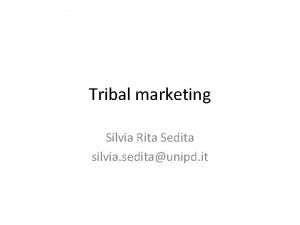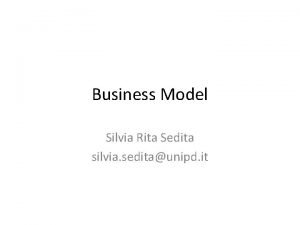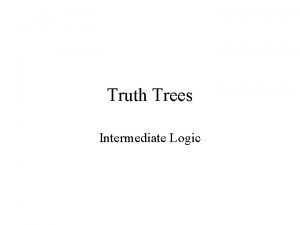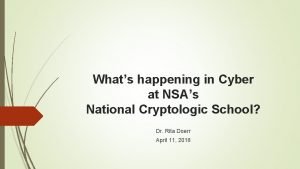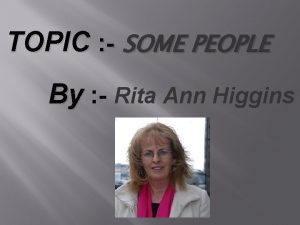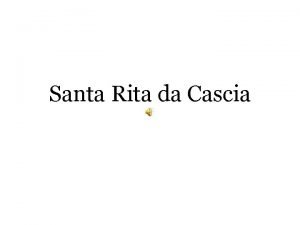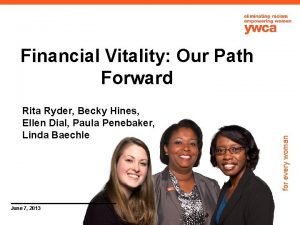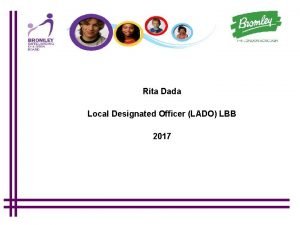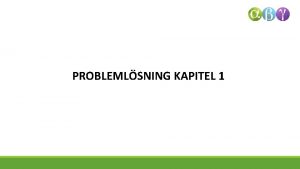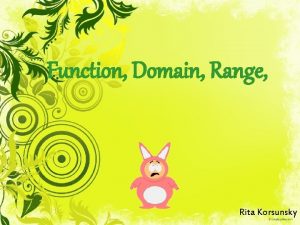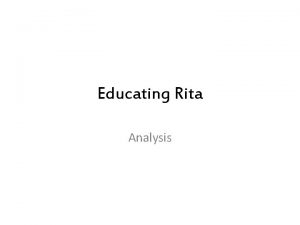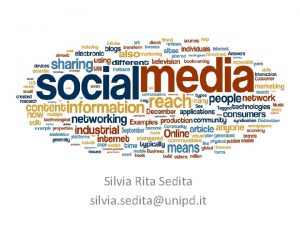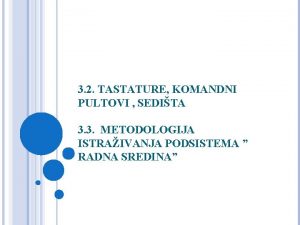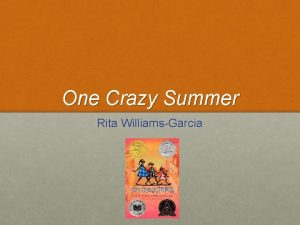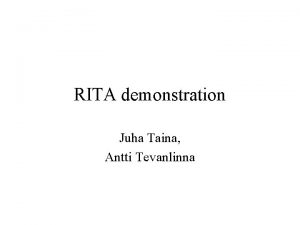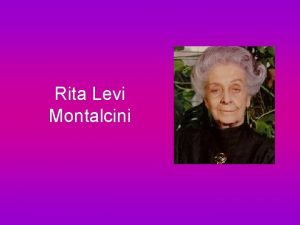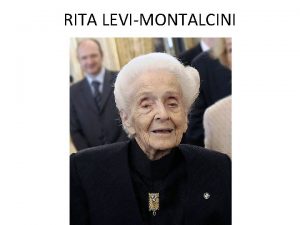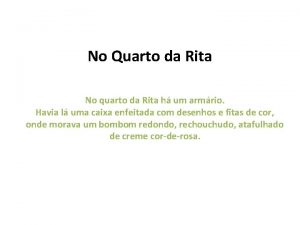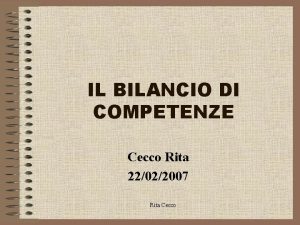Information rules Silvia Rita Sedita silvia seditaunipd it


























- Slides: 26

Information rules Silvia Rita Sedita silvia. sedita@unipd. it

Moore’s Law • Moore’s Law is a computing term which originated around 1970 – Comes from Gordon Moore, co-founder of Intel • the number of transistors on an affordable CPU would double every two years • In other words, processor speeds, or overall processing power for computers will double every two years.


Sarnoff’s Law • It's a relationship called Sarnoff's Law, named for the pioneering RCA television executive and entrepreneur David Sarnoff. • The value of a broadcast network, where a message is sent via radio or TV, is believed to grow linearly: the number of possible network connections increases as the number of users • The implication is the more viewers, the greater the value. • Note that nothing is said about the strength or value of the individual connection.

The Metcalfe’s Law • Comes from Bob Metcalfe, the inventor of Ethernet. • The foundation of his eponymous law is the observation that in a communications network with n members, each can make ( n – 1) connections with other participants. • If all those connections are equally valuable--and this is the big "if" as far as we are concerned--the total value of the network is proportional to n ( n – 1), that is, roughly, n 2. • So if, for example, a network has 10 members, there are 90 different possible connections that one member can make to another. If the network doubles in size, to 20, the number of connections doesn't merely double, to 180, it grows to 380 --it roughly quadruples, in other words. • Note that it says nothing about the strength of the connections just that they are possible and it ignores group conversations.

The Reed’s Law • In 2001, computer scientist David P. Reed (professor at MIT) published a paper called "The Law of the Pack, " in which he described three different types of networks: – one-to-many (broadcast network or Sarnoff network, like TV and radio networks), – one-to-one (transactional network or Metcalfe network, such as emails and instant messaging), – and a group-forming network (GFN or many-to-many). • Reed realized that Metcalfe's law actually understates the value of the third type of network. – GFNs actually increases exponentially with the number of possible subgroups. The value of this network is roughly 2 n, where n is the number of participants. – It says nothing about the value of these subgroups to their members, but is just the mathematical limit of the number of possible subgroups.

Network value The increasing value of a network as its size increases certainly lies somewhere between linear and exponential growth…

Imagine a network of 100 000 members that we know brings in $1 million…and the networks doubles its membership to 200. 000 Let’s measure the growth of value… Sarnoff Metcalfe (200. 000/100. 000)* (200. 000²/100. 000²) 1. 000 = *1. 000 = 2. 000 4. 000 The value doubles Reed nlog(n) (2²°°°°°/2¹°°°°°)*1. 0 (200. 000*log(200. 000= 00)/100. 000*log(10 0. 000))*1. 000 = 2. 120. 412 The value quadruples Exponential growth The value more than doubles

Exponential times crashes into human limitations • The maximum number of stable and persistent social relationships you can manage is determined by some cognitive limit and for humans this is about 150 (Dunbar's Number). • This determines effective organization size, the scale of your meaningful social network and so on. – It is highly debatable, but it is clear the number of relationships is finite - people don't have 1, 000 close personal friends and certainly not 10, 000 (a few Facebook phenoms have millions of "friends"). – More careful analyses suggest we have layers of friends and other social connections and the average limit is on the order of 100 to 300 people. – We usually only have a handful who constitute close personal relationships and maybe a few dozen we might trust.


Example • Consider the biggest store in your city that sells home appliances including vacuum cleaners. Clearly this store has a lot of reach because many people know about this store. You can go and buy a vacuum cleaner from there. However, almost certainly you are not going to get a lot of detailed information about the vacuum cleaner you are buying because the sales man there sells many other brand names and can even be a sales man for other types of appliances. • On the other hand, think of the sales man that comes to your house and wants to sell you a certain type of a vacuum cleaner. Obviously, he would answer all of your questions about the vacuum cleaner and will give you lots of additional information about it. Clearly the information you get from him is very rich, however its reach is low.

Reachness vs. Richness • The reach of information is defined as ‘the number of people who participate in the sharing of that information’. • The richness vs. reach concept means that the richer the information is the less reach it has and vice versa. • Internet overcomes the trade-off between reachness and richness

Amazon - reach • The reach of Amazon is extremely large, almost anyone who has bought a book online knows about this company. • It has sold millions of books in a fairly quick time. • Richness is provided to the customer in many forms at the site

Amazon - richness • • • Reviews and exchanges with other readers Personal recommendations Customized login screen Communication Interviews and exchanges with authors


About reach… • The Ice Bucket Challenge, sometimes called the ALS Ice Bucket Challenge, is an activity involving dumping a bucket of ice water on someone's head to promote awareness of the disease amyotrophic lateral sclerosis (ALS) and encourage donations to research. It went viral on social media during July–August 2014. • In the US, many people participate for the ALS Association, and in the UK, many people participate for the Motor Neurone Disease Association, although some individuals have opted to donate their money from the Ice Bucket Challenge to other organizations. • The challenge encourages nominated participants to be filmed having a bucket of ice water poured on their heads and then nominating others to do the same. A common stipulation is that nominated participants have 24 hours to comply or forfeit by way of a charitable financial donation. • http: //www. youtube. com/watch? v=XS 6 ys. DFTb. LU

Six degree • Six degrees of separation is theory that everyone and everything is six or fewer steps away, by way of introduction, from any other person in the world, so that a chain of "a friend of a friend" statements can be made to connect any two people in a maximum of six steps. • http: //oracleofbacon. org/index. php • On January 18, 2007, Kevin Bacon launched Six. Degrees. org, a web site that builds on the popularity of the "small world phenomenon" to create a charitable social network and inspire giving to charities online.

Summing up • New ICTs allow people to be connected even if geographically dispersed – From world-of-mouth to world-of-mouse • More information is travelling around, and customers are smarter – Customer empowerment • Companies can benefit from network externalities – Market extension and brand awereness • But do not forget that reachness is not enough! – Information passed over the web must be meaningful • Consumers must be involved in fruitful conversations leading to customer loyalty – Co-creation and prosumers…

On-line marketing mix B 2 C Communication C 2 C Communication 4 Ps The 3 Cs model

New business models • The informative interactive nature of ICTs favours the emergence of new business models – Pure on-line – Hybrids (on-line and off-line)


Main social media indicators • Engagement Rate – measures the number of "likes" and comments that your business has received and divides it by a total fan count. – Not only can it help you to determine the type of content that your target audience finds most appealing, but it can make you aware of the best times of day to post content. • Sentiment – Is associated with an article/post. All articles/posts are then attributed a positive, neutral or negative sentiment.

Main social media indicators • Social Page Views – Knowing at any point in time how many people have viewed your Facebook page is valuable information, and perhaps more meaningful than knowing the number of views that your business's website is getting. • Video/Slide. Share Views – Making yourself aware of the number of times that people have tuned into your You. Tube video or viewed your Slide. Share presentation can help you to measure the success of your content and gauge whether it's engaging your target audience or not gaining much traction.

Main social media indicators • Talking About This – The number of people that are talking about your brand. Basically, this metric tracks the number of people that are talking about your brand and/or your posts on their Facebook page. • Reach – The reach of an article/post represents the number of people who were reached by this article/post.

Let’s compare Zara and H&M • http: //www. talkwalker. com/it/ricerca-analisisocial-media/

References • Odlyzko, A. , & Tilly, B. (2005). A refutation of Metcalfe’s Law and a better estimate for the value of networks and network interconnections. University of Minnesota. • Evans, P. , & Wurster, T. S. (2000). Blown to bits: How the new economics of information transforms strategy. Harvard Business Press.
 The conversation prism
The conversation prism Silvia rita
Silvia rita Sedita historie
Sedita historie Benthosphere
Benthosphere Keys to content writing
Keys to content writing Sedita sidlo
Sedita sidlo Shorter truth table method
Shorter truth table method Unlike traditional production rules, association rules
Unlike traditional production rules, association rules National cryptologic school
National cryptologic school Strong dislike; bitter hostility
Strong dislike; bitter hostility Fekete rita
Fekete rita Some people poem
Some people poem Rita goldmane
Rita goldmane Di rita al nome fuggono
Di rita al nome fuggono Dial rita
Dial rita Rita joe i lost my talk poem
Rita joe i lost my talk poem Lado bromley
Lado bromley Rita and holly are identical twins
Rita and holly are identical twins Rita en bild
Rita en bild Maria rita petrillo
Maria rita petrillo Csőke rita
Csőke rita Rita voigt
Rita voigt Rita wadey
Rita wadey Rita korsunsky
Rita korsunsky Extreme sports examples
Extreme sports examples Shawshank redemption short summary
Shawshank redemption short summary Educating rita analysis
Educating rita analysis
